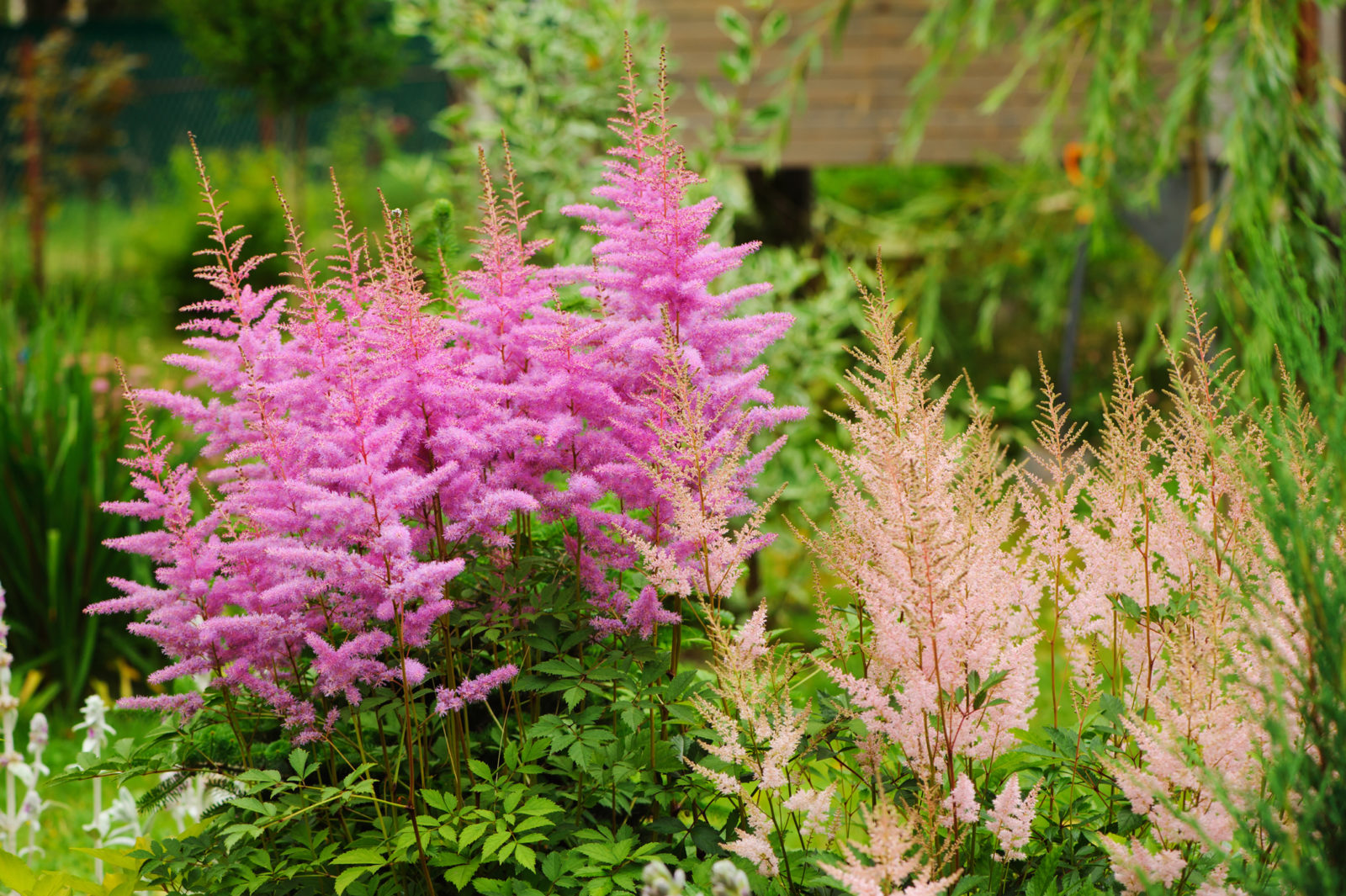PERENNIALS > ASTILBE > VARIETIES
Chris is a gardening writer and nature enthusiast. He graduated from Oxford Brookes University in 2022 with an MA in Psychology. Chris works with the Leeds Green Action Society, helping their food cooperative by growing various fruit and vegetables on their two allotments in Hyde Park, Leeds.
Reviewed By ROY NICOL

Roy is a Professional Gardener and Horticultural Consultant, specialising in large garden year-round maintenance and garden development. He is an RHS Master of Horticulture and uses his research in the application of no-dig methods in ornamental garden settings. Roy has been a Professional Gardener for more than six years and is a member of the Chartered Institute of Horticulture, Professional Gardener's Guild and Association of Professional Landscapers (Professional Gardener).
IN THIS GUIDE
ASTILBE GUIDES
Bare Root Planting
Container Growing
Division
Growing From Seed
Overwintering
Pruning
Varieties
On your next stroll through mountainous areas or woodlands in Asia and North America, keep your eyes peeled for splashes of colour in your undergrowth – you may well be looking at Astilbe.
Or, much more likely, keep your eyes peeled for one of these fashionable plants next time you head to a garden centre!
Astilbes are popular thanks to their colourful foliage that sometimes resembles heather, their dense blooms, and their propensity to do well when planted near water.
Below we’ve rounded up a handful of popular Astilbe varieties to grow.
If you’re keen to incorporate this plant into your outside space, these varieties should provide a helpful starting point.

We’ve prioritised varieties in receipt of the Royal Horticultural Society’s Award of Garden Merit.
This indicates suitability for growth in British gardens, meaning they’ll theoretically perform reliably and give you an easier time than some other options.
All of the varieties in the list below should be grown in partial shade and in an exposed or sheltered location.
1) A. ‘Montgomery’

- COMMON NAME(S): Astilbe ‘Montgomery’
- HARDINESS RATING: H7
- FLOWERS: Red
- FLOWERING SEASON(S): Summer
- FOLIAGE: Red and bronze
- SOIL PREFERENCE: Loam; Any pH
- SIZE: 0.5-1m in height, 0.5-1m spread
With a dazzling bloom that sits on the threshold between crimson red and neon pink, ‘Montgomery’ is sure to catch the eye.
With this variety, it’s easy to see where the heather comparison comes from.
‘Montgomery’ will be at its most colourful in summer, with the bloom fading through to winter.
The foliage also lends a splash of colour throughout the year.
For this variety, choose somewhere with loamy soil – ‘Montgomery’ will tolerate poorly-drained soil of any pH.
Roy Nicol, a Professional Gardener and Master Horticulturist, states that: “‘Mongomery’ should be grown in part shade and south-facing aspects should be avoided.”
2) A. ‘Bressingham Beauty’

- COMMON NAME(S): Astilbe ‘Bressingham Beauty’
- HARDINESS RATING: H7
- FLOWERS: Pink
- FLOWERING SEASON(S): Summer
- FOLIAGE: Green and bronze
- SOIL PREFERENCE: Loam; Any pH
- SIZE: 0.5-1m in height, 0.5-1m spread
This Astilbe variety has proud pink plumage during the summer, making a shorter but dare we say it, bolder impression than ‘Montgomery’.
The delicate flowers reward careful appreciation: lean in close to appreciate their gentle filigree.
As with ‘Montgomery’, the ‘Bressingham Beauty’ variety likes loamy soil and will be fine in a poorly-drained spot avoiding south-facing aspects.
3) A. chinensis var. taquetii ‘Purpurlanze’
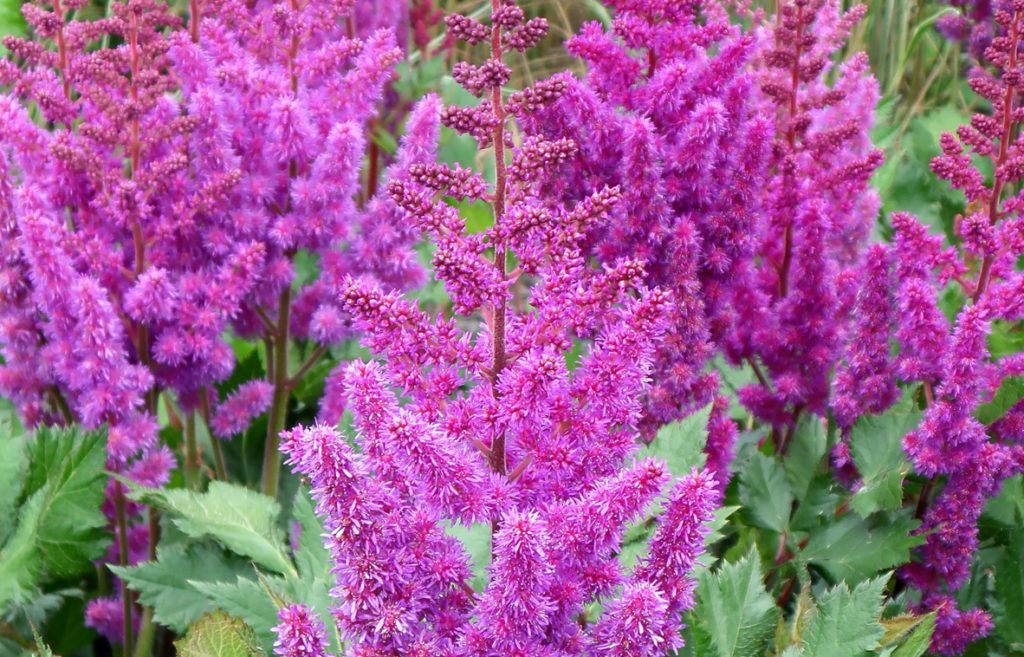
- COMMON NAME(S): Chinese astilbe ‘Purpurlanze’
- HARDINESS RATING: H7
- FLOWERS: Purplish-red
- FLOWERING SEASON(S): Summer / Autumn
- FOLIAGE: Green
- SOIL PREFERENCE: Loam; Any pH
- SIZE: 1-1.5m in height, 0.1-0.5m spread
‘Purpurlanze’ translates from German as ‘crimson lance’ but, confusingly, you may also see this variety called purple lance, a name which does far more to capture the essence of the plant.
This variety of Astilbe has, you guessed it, purple, lance-like panicles of flowers.
Along with ‘Montgomery’, this variety showcases the beautiful colouration Astilbe is capable of contributing to your garden.
Pink flowers are ten-a-penny, but the rich and deep red purples are fewer and further between.
Select a spot with loamy soil, either well-drained or poorly-drained.
Avoid a south-facing aspect for this variety, too.
4) A. simplicifolia
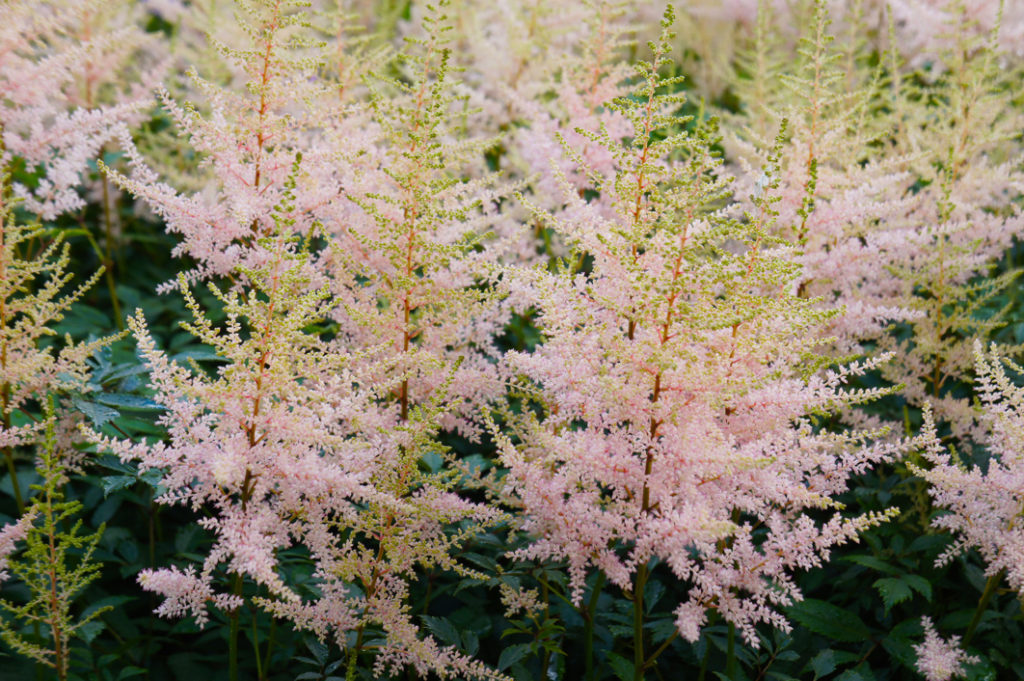
- COMMON NAME(S): Entire-leaved astilbe
- HARDINESS RATING: H5
- FLOWERS: White
- FLOWERING SEASON(S): Summer
- FOLIAGE: Green
- SOIL PREFERENCE: Loam; Any pH
- SIZE: 0.1-0.5m in height, 0.1-0.5m spread
This dwarf variety has a dalliance and dainty bloom of white flowers, giving a more subdued bloom than previous varieties we’ve seen, but, as with ‘Bressingham Beauty’, it’s a bloom that still rewards careful appreciation.
Expect floral blooms about 30cm in height when this variety reaches maturity.
The preferred conditions are the same as the previous two varieties we’ve seen.
5) A. chinensis var. pumila

- COMMON NAME(S): Dwarf Chinese astilbe
- HARDINESS RATING: H7
- FLOWERS: Rosy-mauve
- FLOWERING SEASON(S): Summer
- FOLIAGE: Red and green
- SOIL PREFERENCE: Clay or loam; Any pH
- SIZE: 0.1-0.5m in height, 0.1-0.5m spread
Another dwarf variety here, to give a bit of choice to gardeners looking for a plant to fill a small spot.
The mauve flowers of the dwarf Chinese Astilbe are lovely, contrasting boldly with the rich green leaves they rise above.
This variety will bloom in summer and will reach a max height of about 25cm at its peak.
Conditions are familiar by this point: loam, well-drained or poorly-drained soil and any aspect except south-facing.
“This plant will also tolerate clay soils,” share Roy.
6) A. glaberrima saxosa
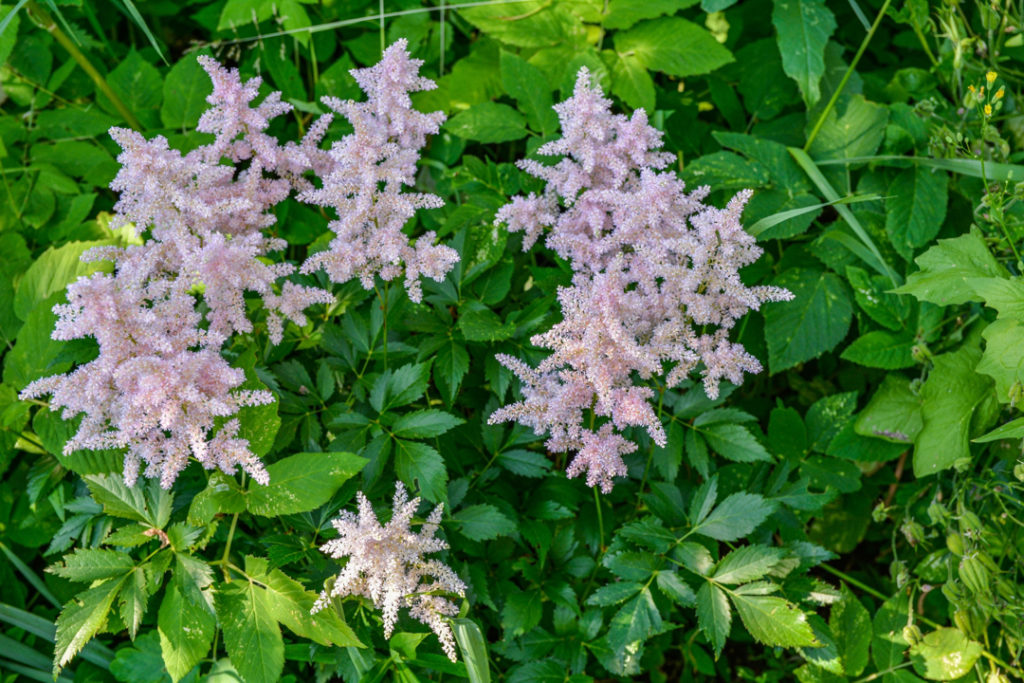
- COMMON NAME(S): Smooth rock astilbe
- HARDINESS RATING: H5
- FLOWERS: Pink and white
- FLOWERING SEASON(S): Summer
- FOLIAGE: Green
- SOIL PREFERENCE: Loam; Any pH
- SIZE: 0.1m in height, 0.1-0.2m spread
Here’s an Astilbe variety that clocks in even smaller than the two dwarf varieties we’ve just been introduced to.
This compact specimen will grow to a height of about 15cm, packing all of the features that make Astilbes so popular into a diminutive space.
There are the vibrant leaves and the panicled blooms, and the summertime floral display to boot.
Conditions here are familiar, too.
Just note that this variety is less hardy than other varieties.
This means that the minimum comfortable temperature for this variety is slightly warmer, around -15°C.
This is still unlikely to be an issue in the UK, but it’s definitely worth knowing about.
7) A. chinensis var. taquetii ‘Superba’
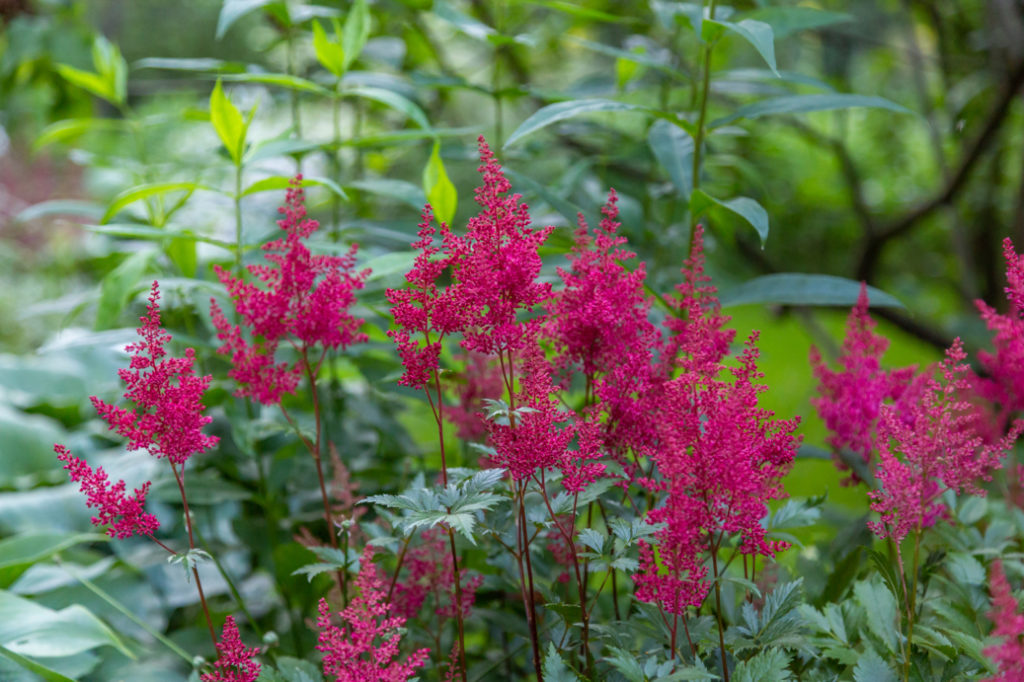
- COMMON NAME(S): Chinese astilbe ‘Superba’
- HARDINESS RATING: H7
- FLOWERS: Rosy-mauve
- FLOWERING SEASON(S): Summer
- FOLIAGE: Green
- SOIL PREFERENCE: Loam; Any pH
- SIZE: 1-1.5m in height, 0.1-0.5m spread
We’ve had a couple of smaller varieties, so let’s go back to an Astilbe that stands tall and proud.
‘Superba’ lives up to its name, standing proud at around 1.5m off the ground at full height.
This lofty stature means that ‘Superba’ flowers will wave alluringly above other flowers in your garden, rather than tucking themselves into, or even under, other displays.
The green foliage and pink floral colouration are very distinctively Astilbe, as are its preferred conditions.
This H7 hardy variety will do well in loam, well or poorly-drained soil, in south, west, or east-facing aspect.
8) A. ‘Straussenfeder’

- COMMON NAME(S): Astilbe ‘Straussenfeder’
- HARDINESS RATING: H7
- FLOWERS: Pink
- FLOWERING SEASON(S): Summer
- FOLIAGE: Green and bronze
- SOIL PREFERENCE: Loam; Any pH
- SIZE: 0.5-1m in height, 0.1-0.5m spread
Another tall Astilbe variety here: the ‘Straussenfeder’ reaches heights of around 1m, meaning its characteristic pink blooms can readily flaunt themselves and their pleasing bronze tint.
This is a nice variety to have in your garden.
No prizes for guessing its favourite conditions: loam, well or poorly-drained soil, no south-facing aspects.
9) A. ‘Brautschleier’

- COMMON NAME(S): Astilbe ‘Brautschleier’
- HARDINESS RATING: H7
- FLOWERS: White
- FLOWERING SEASON(S): Summer
- FOLIAGE: Green
- SOIL PREFERENCE: Loam; Any pH
- SIZE: 0.5-1m in height, 0.1-0.5m spread
Another Astilbe of German heritage here, with ‘Brautschleier’ translating as ‘bridal veil’ in English.
Sometimes you come across a flower with a name so perfectly suited that all you can do is nod as you read it, and this is a fine example.
The busily elegant white floral bloom brings to mind a bride in her dazzling wedding day dress, and it’s an aesthetic that can be put to such good use in any garden.
Conditions are the same as the previous variety.
10) A. ‘Bronce Elegans’

- COMMON NAME(S): Astilbe ‘Bronze Elegance’
- HARDINESS RATING: H7
- FLOWERS: Pink and cream
- FLOWERING SEASON(S): Summer
- FOLIAGE: Green and bronze
- SOIL PREFERENCE: Loam; Any pH
- SIZE: 0.1-0.5m in height, 0.1-0.5m spread
The final Astilbe variety in our list is the ‘Bronce Elegans’ or, as it’s also commonly known, bronze elegance.
This variety joins the other dwarves and compacts we’ve seen previously, and its name captures that characteristic bronze tint common to so many members of the Astilbe family.

